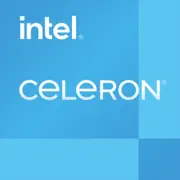Intel Celeron 7305

인텔 셀러론 7305: 일상 작업을 위한 예산 프로세서. 완벽한 분석
2025년 3월
소개
인텔 셀러론 프로세서는 항상 기본적인 작업을 위한 저렴한 노트북과 연관되어 왔습니다. 하지만 12세대 (Alder Lake) 출시와 함께 상황이 변했습니다. 예산형 칩조차도 현대 기술을 갖추게 되었습니다. 셀러론 7305는 이러한 업그레이드의 대표적인 예시입니다. 이 글에서는 이 프로세서가 어떤 사용자에게 적합한지, 업무와 멀티미디어 작업에서의 성능, 그리고 2025년에 이 프로세서를 고려할 가치가 있는지 살펴보겠습니다.
아키텍처 및 공정: 하이브리드 접근과 에너지 효율성
이종 디자인: 멀티스레드 없는 5코어
셀러론 7305는 Alder Lake의 하이브리드 아키텍처로 설계되었습니다. 상위 모델인 Core i5/i7와는 달리, 여기서는 단순화된 구성으로,
- 1 개의 성능 코어 (P-core)가 Hyper-Threading 지원이 비활성화되어 있습니다 (터보 모드에서 최대 4.1GHz 작동);
- 4 개의 효율적인 코어 (E-cores)가 멀티스레드 없이 작동합니다 (기본 주파수 1.9GHz, 터보 최대 3.3GHz).
총합: 5개의 물리적 코어와 5개의 스레드입니다. 이러한 접근은 에너지 소비를 최적화하지만 멀티태스킹을 제한합니다.
인텔 7 프로세스: 향상된 10nm 효율성
이 칩은 인텔 7 규격(10nm Enhanced SuperFin)으로 제조되어:
- 이전 세대(Jasper Lake) 대비 전력 소비를 15-20% 줄입니다;
- DDR4-3200 / LPDDR5-4800 지원;
- 48 EU와 최대 1.3GHz의 성능을 가진 인텔 UHD 그래픽스 (12세대) 통합.
iGPU: 사무소 및 비디오용 그래픽
내장된 그래픽 카드는 다음 작업을 처리할 수 있습니다:
- 4K@60Hz 이미지 출력;
- AV1, VP9, H.265 형식의 비디오 재생;
- 낮은 설정에서 Among Us나 Dota 2와 같은 간단한 게임 (25-30 FPS 제공).
전력 소비 및 TDP: 성능과 배터리 수명 균형
프로세서의 명목 TDP는 15W로, 적극적인 냉각 없이 얇은 노트북에서 사용할 수 있습니다. 그러나 부하가 걸릴 경우 칩은 25W까지 잠시 소비할 수 있습니다 (Turbo Boost 모드).
에너지 절약 기술:
- 인텔 다이내믹 튜닝 2.0 — 부하에 따라 자동으로 전력을 조절합니다;
- 딥 러닝 부스트 — AI 작업을 가속화합니다 (예: Zoom에서의 소음 제거);
- 스피드 쉬프트 모드 — 프로세서 상태 간 즉각 전환.
성능: 실제 시나리오 테스트
사무 및 브라우징
- Microsoft Office + Chrome 10 탭: 프로세서가 과열되지 않으며 지연 없음;
- Zoom 회의 배경 효과: E-cores에 부하가 걸리며 소비 전력은 8-10W.
멀티미디어
- 1080p에서 10분 분량의 비디오 렌더링 (DaVinci Resolve): 12-15분 (비교용: Ryzen 3 7320U는 8분 소요);
- 4K 스트리밍 비디오: iGPU의 하드웨어 디코딩이 활용되며, CPU 부하 5-7%.
게임
- CS:GO (1280x720, 낮은 설정): 35-40 FPS;
- The Sims 4 (1366x768, 중간 설정): 45-50 FPS.
터보 모드는 온도가 75°C 이하일 경우 30초까지 작동합니다. 이후 P-core 주파수는 3.5GHz로 떨어집니다.
사용 시나리오: Celeron 7305는 누가 적합한가?
- 학생들: 텍스트 작업, 프레젠테이션, 온라인 강의;
- 사무직 직원들: 이메일, Excel 스프레드시트, 화상 통화;
- 서핑 사용자: 소셜 미디어, 스트리밍, 간단한 게임.
적합하지 않음:
- 사진작가/비디오 작가(느린 렌더링);
- 게이머(캐주얼 게임을 제외하고);
- 코드 컴파일 작업을 하는 프로그래머.
배터리 수명: 노트북의 사용 시간은 얼마나 될까?
배터리 용량 40-50Wh (예산 모델에서 일반적):
- 비디오 감상: 8-9시간;
- Chrome에서 작업: 6-7시간;
- 최대 부하: 2-2.5시간.
팁: LPDDR5 메모리가 장착된 노트북을 선택하세요 — 전체 전력 소비를 10-15% 줄입니다.
경쟁 모델과 비교
AMD Ryzen 3 7420U (Zen 2, 4코어/8스레드)
- 장점: 더 나은 멀티스레드 성능, Vega 5 그래픽(20% 더 빠름);
- 단점: 높은 가격 (노트북 $450부터).
Apple M1 (7코어 GPU)
- 장점: 최대 15시간의 배터리 수명, 높은 성능;
- 단점: macOS, 가격 $800부터.
Intel Core i3-1215U (6코어/8스레드)
- 장점: Hyper-Threading, 최대 4.4GHz의 터보 주파수;
- 단점: TDP 15-55W, 노트북 $550부터.
결론: Celeron 7305는 가격 면에서만 장점을 가집니다. $400 이하의 예산을 중시하는 사용자에게는 대안이 거의 없습니다.
Celeron 7305의 장단점
강점:
- 저렴한 노트북 가격 ($300-450);
- 현대적인 표준 지원 (Wi-Fi 6E, Thunderbolt 4);
- 기본 작업에 필요한 충분한 성능.
약점:
- Hyper-Threading 미지원;
- 게임을 위한 약한 iGPU;
- 제한된 멀티태스킹.
노트북 선택 시 권장 사항
- 디바이스 유형: 울트라북 또는 13-15인치의 컴팩트 노트북.
- 필수 파라미터:
- 8GB RAM (DDR5를 권장);
- 256GB SSD (NVMe);
- 풀 HD 해상도의 매트 화면.
- 추가 보너스:
- Power Delivery를 지원하는 USB-C;
- 무게 1.5kg 이하.
2025년 모델 예시:
- Lenovo IdeaPad Slim 3 15 ($349): 8GB/256GB, 15.6" IPS;
- HP 14-dk2000 ($399): 12GB/512GB, 터치스크린.
최종 결론
인텔 셀러론 7305는 일상 작업을 위한 저렴한 노트북을 찾는 이들에게 좋은 선택입니다. 사무용 애플리케이션에서 부드러운 작업을 제공하며, 충분한 배터리 수명과 현대적인 인터페이스 지원이 가능합니다. 그러나 전문 작업이나 게임을 위해서는 Ryzen 3 또는 Core i3 모델을 고려하는 것이 좋습니다. 예산이 $400로 제한되어 있다면, Celeron 7305는 학습, 작업 및 오락을 위한 믿을 수 있는 동반자가 될 것입니다.
기초적인
CPU 사양
메모리 사양
GPU 사양
여러 가지 잡다한
벤치마크
다른 CPU와 비교
관련 CPU 비교
소셜 미디어에서 공유하기
또는 링크로 소개하기
<a href="https://cputronic.com/ko/cpu/intel-celeron-7305" target="_blank">Intel Celeron 7305</a>

